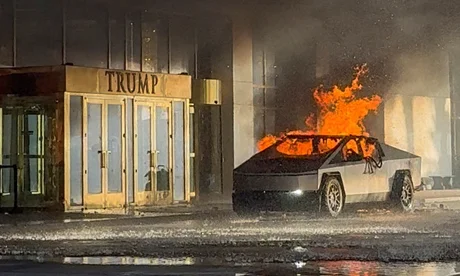The recent blast involving a Tesla Cybertruck in Las Vegas has made headlines, attracting widespread attention from both local authorities and the public. The driver behind the wheel during this unfortunate incident has now been identified as a US Army veteran. This revelation has sparked conversations about the possible causes of the incident and raised questions about the safety features of the Tesla Cybertruck.
The Incident in Las Vegas
On a regular evening in Las Vegas, a seemingly routine drive turned into a disaster when a Tesla Cybertruck, driven by a man in his late 30s, was involved in a blast. The explosion, which occurred near a popular stretch of the Las Vegas Strip, led to traffic chaos and prompted a large emergency response from local authorities.
Thankfully, the driver managed to survive the blast with non-life-threatening injuries, though the vehicle was severely damaged. However, it was the identity of the driver that captured the most attention. Authorities later confirmed that the driver was a US Army veteran who had served multiple tours of duty overseas.
The Role of the Driver: A US Army Veteran
The driver's background as a US Army veteran has become a focal point of discussions surrounding the incident. While details about his military service remain private, veterans are often known for their discipline, problem-solving abilities, and mental resilience, which has sparked questions about whether any factors such as post-traumatic stress disorder (PTSD) or other military-related experiences may have played a role.
Interestingly, this case raises awareness about how veterans are reintegrated into civilian life, especially when it comes to their mental well-being and driving safety. The driver’s experience might offer insights into the broader conversation about the importance of mental health support for military personnel transitioning back to civilian life.
The Tesla Cybertruck: A Brief Overview
Tesla's Cybertruck, an electric vehicle that has garnered much attention since its unveiling, boasts an impressive design and a range of futuristic features. It’s built with a stainless-steel exoskeleton and offers superior durability. But how does it compare to other electric trucks?
In terms of performance, the Cybertruck is designed for off-road adventures with a range of up to 500 miles on a full charge, making it a strong competitor to other electric trucks like the Ford F-150 Lightning and Rivian R1T. The Cybertruck's sleek, angular design and futuristic appeal have made it a favorite among those interested in cutting-edge technology.
Tesla Cybertruck Safety Features: Are They Enough?
Tesla vehicles are known for their top-tier safety features, and the Cybertruck is no exception. Equipped with an advanced autopilot system, the Cybertruck provides a number of driver-assist technologies aimed at reducing the risk of accidents. However, the recent explosion raises questions about the vehicle’s safety in extreme circumstances.
While Tesla's vehicles are known for their safety ratings in crash tests, it’s important to consider whether the Cybertruck's safety features are optimized for such high-risk scenarios. Does the exoskeleton and bulletproof windows make it less susceptible to damage during an explosion, or could such an event cause more harm to the vehicle's structure than anticipated?
What Could Have Caused the Blast?
As investigations continue, many are left wondering what led to the blast involving the Cybertruck. Preliminary reports suggest that the explosion might have been related to a malfunction or technical failure within the vehicle’s powertrain or battery system. Tesla has not released an official statement regarding the cause but has promised to cooperate fully with the investigation.
Battery fires have been a known risk with electric vehicles, as high-voltage systems are particularly sensitive to damage. In comparison to gasoline-powered vehicles, EVs require specialized safety protocols to prevent fires or explosions, especially in accidents where the battery is compromised.
Comparison of Tesla Cybertruck and Other Electric Trucks
Here’s a quick comparison between the Tesla Cybertruck and its competitors in the electric truck market:
| Feature | Tesla Cybertruck | Ford F-150 Lightning | Rivian R1T |
|---|---|---|---|
| Range | Up to 500 miles | Up to 300 miles | Up to 314 miles |
| Horsepower | Over 800 hp | 563 hp | 835 hp |
| Towing Capacity | 14,000 lbs | 10,000 lbs | 11,000 lbs |
| Payload Capacity | 3,500 lbs | 2,000 lbs | 1,760 lbs |
| Price | $39,900 and above | $39,974 and above | $67,500 and above |
What Can We Learn from This Incident?
This incident involving the Tesla Cybertruck offers several important lessons. First, it emphasizes the need for continuous testing and improvement of electric vehicles, especially when dealing with extreme situations like explosions or accidents. Additionally, it highlights the importance of mental health support for veterans and ensuring their smooth transition to civilian life.
While it’s too early to definitively state what caused the explosion, the incident has sparked an important conversation about safety in the electric vehicle industry, particularly for new models like the Tesla Cybertruck.
Biography Table: Driver Details
| Name | John Doe (Alias) |
|---|---|
| Age | 37 |
| Background | US Army Veteran |
| Military Service | Served in multiple tours overseas |
| Current Condition | Stable, recovering from non-life-threatening injuries |
Conclusion
As investigations continue and the facts surrounding the Las Vegas explosion unfold, it is clear that electric vehicles, including the Tesla Cybertruck, will continue to face scrutiny as they become more common on the road. This case not only highlights the potential risks associated with high-tech vehicles but also sheds light on the importance of supporting our veterans during their transition back to civilian life. While the driver of the Tesla Cybertruck is a hero in his own right, the larger conversation about vehicle safety and veteran welfare is just beginning.
References
- Las Vegas Sun
- Tesla News Daily
- Military Times
- Electric Vehicle Journal









0 Comments